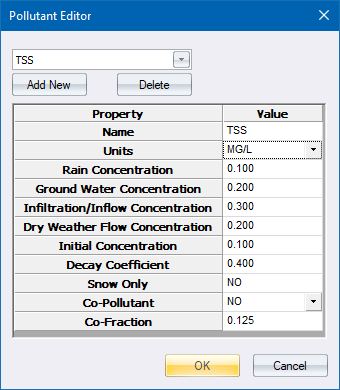

The SWMM method can simulate the generation, inflow and transport of any number of user-defined pollutants. Required information for each pollutant includes:
Pollutant name.
Concentration units i.e. milligrams/litre, micrograms/litre, or counts/litre.
Concentration in rainfall.
Concentration in groundwater.
Concentration in inflow/infiltration.
Co-pollutants can also be defined. For example, pollutant X can have a co-pollutant Y, meaning that the runoff concentration of X will have some fixed fraction of the runoff concentration of Y added to it.
Pollutant buildup and washoff from subcatchment areas are determined by the land uses assigned to those areas. Input loadings of pollutants to the drainage system can also originate from external time series inflows, as well as from dry weather inflows.
|
Option
|
Description |
|
Pollutant Selector |
Select the pollutant to edit. |
|
Add |
Click to add a new pollutant to the project. |
|
Delete |
Click to delete a pollutant from the project. |
|
Pollutant Name |
The name assigned to the pollutant. |
|
Units |
The concentration units - (mg/L, ug/L, or #/L (counts/L) - in which the pollutant concentration is expressed.
|
|
Rain Concentration |
Concentration of the pollutant in rain water (concentration units). |
|
Ground Water Concentration |
Concentration of the pollutant in ground water (concentration units). |
|
Infiltration/Inflow Concentration |
Concentration of the pollutant in any Infiltration/Inflow (concentration units). |
|
Dry Weather Flow Concentration |
Concentration of the pollutant in dry weather flow. |
|
Initial Concentration |
Concentration of the pollutant at the start of the simulation. |
|
Decay Coefficient |
First-order decay coefficient of the pollutant (1/days). |
|
Snow Only |
YES if pollutant buildup occurs only when snowfall occurs; or NO otherwise (default is NO). Double-click to toggle between YES/NO. |
|
Co-Pollutant |
Name of another pollutant whose runoff concentration contributes to the runoff concentration of the current pollutant. An example of a co-pollutant relationship would be where the runoff concentration of a particular heavy metal is some fixed fraction of the runoff concentration of suspended solids. In this case, suspended solids would be declared as the co-pollutant for the heavy metal. |
|
Co-Fraction |
Fraction of the co-pollutant's runoff concentration that contributes to the runoff concentration of the current pollutant. |
You can edit the properties of existing pollutants, create new pollutants or delete existing pollutants.
See Also Land Uses, Pollutant Buildup, Pollutant Washoff, Inflows Editor.